Abstract
Social networking software is ubiquitous, from Facebook to Flickr, defining the internet for many users. However, this is a recent phenomenon. Is the timing due to socio-technical determinism, inspiration of individuals, or sheer chance? While much has been written about recent successful social networking sites, this paper takes a different approach and examines vfridge, a social networking application developed 10 years ago, well before the current explosion, which, despite a vision that now seems prescient, was unsuccessful. The reasons for failure are partly about timing and market conditions, but also yield valuable lessons for future innovative applications.
Keywords: social network, adoption, web2.0, web architecture
References
-
Basalla, G. (1988). The evolution of technology. Cambridge University Press.
-
boyd, d. and Ellison, N. (2008). Social network sites: Definition, history, and scholarship. Jnl of Computer-Mediated Comm, 13(1), 210–230.
-
boyd, d. (2004). Friendster and Publicly Articulated Social Networks. In CHI 2004, pp. 1279–1282.
-
Brynjolfsson, E. and Kemerer, C. (1996) Network Externalities in Microcomputer Software: An Econometric Analysis of the Spreadsheet Market. Management Science, 42(12), 1627–1647.
-
Cockburn, A. (1993a) Groupware design: principles, prototypes, and systems. PhD thesis, University of Stirling, Scotland.
-
Cockburn, A. and Thimbleby, H. (1993b) Reducing user effort in collaboration support. In Proc. of IUI '93, pp. 215-218.
-
Crabtree, A. and Rodden, T. (2004) Domestic routines and design for the home, Computer Supported Cooperative Work: The Journal of Collaborative Computing, 13(2), 191-220.
-
Dix, A. (1997) Challenges for Cooperative Work on the Web: An analytical approach. Computer-Supported Cooperative Work, 6, 135-156. http://www.hcibook.com/alan/papers/CSCW+WWW/
-
Dix, A. (1999) Annotations a UI Perspective (panel presentation), COOPIS'99, Edinburgh Sept. 1999. http://www.hcibook.com/alan/papers/coopIS99/
-
Dix, A., 1999b. The Web Sharer Vision. eBulletin, aQtive Ltd., November 1999.
http://www.hiraeth.com/alan/ebulletin/websharer/
-
Dix, A. (2000) Designing a virtual fridge (poster). Computers and Fun 3, York, 13th December 2000. appears in Interfaces, 46, 10-11. http://www.vfridge.com/research/candf3/candf.html
-
Dix, A. Beale, R. and Wood, A. (2000b). Architectures to make Simple Visualisations using Simple Systems. Proc. of AVI2000, ACM, pp51–60. http://www.hcibook.com/alan/papers/avi2000/
-
Dix, A. and Shabir, N. (2011). Chapter 3: Human-Computer Interaction and Web Design. In Proctor, R. and Vu, K. (eds), Handbook of Human Factors in Web Design, second edition. Lawrence Erlbaum. http://www.hcibook.com/alan/papers/web-hci-2011/
-
Donahue, J. and Widom, J. (1986) Whiteboards: a graphical database tool. ACM Trans. Inf. Syst. 4(1), 24-41.
-
Economides, N. (1996) The Economics of Networks. Intnl. Jnl of Industrial Org.. Oct. 1996
-
Facebook (2011). Company Timeline. http://www.facebook.com/press/info.php?timeline
-
Feldt, K. (2007). Programming Firefox: Building Rich Internet Applications with XUL. O'Reilly Media. pp. 76–77. ISBN 0596102437.
-
Fielding, R. and Taylor. R. (2002). Principled design of the modern Web architecture. ACM Trans. Internet Technol. 2(2), 115-150.
-
Ferebee, S. and Davis, J. (2009). Factors that persuade continued use of Facebook among new members. In Proc. of Persuasive '09. ACM, Art. 35.
-
Goldfarb, B., Kirsch, D. and Miller, D. (2007). Was There Too Little Entry During the Dot Com Era? Journal of Financial Economics, 86(1),100-144.
-
Grudin, J. (1988) Why CSCW applications fail: problems in the design and evaluation of organizational interfaces. in Proc. of CSCW '88, ACM, pp. 85-93.
-
Hart, J., Ridley, J., Taher, F., Sas, C. and Dix, A. (2008). Exploring the facebook experience: a new approach to usability. In Proc. of NordiCHI '08. ACM, pp.471-474.
-
Hudak, P. (1989). Conception, evolution, and application of functional programming languages. ACM Comput. Surv. 21(3), 359-411.
-
Jordan, D. and Smith, P. (2007). Nonlinear Ordinary Differential Equations: An Introduction for Scientists and Engineers. Oxford University Press
-
jQuery (2011) jQuery: The Write Less, Do More, JavaScript Library. http://jquery.com/ (22 Jan 2011)
Katifori, A., Lepouras, G., Dix, A. and Kamaruddin, A. (2008). Evaluating the Significance of the Desktop Area in Everyday Computer Use. in First Intnl. Conf. on Adv. in Computer-Human Interaction, ACHI 2008. IEEE, pp. 31-38.
-
Kirman, B., Lawson, S., Linehan, C., Martino, F.,
Gamberini, L. and Gaggioli, A. (2010). Improving social game engagement on Facebook through enhanced socio-contextual information. In Proc. of CHI '10. ACM, pp.1753-1756.
-
Krasner, G. and Pope, S. (1988). A cookbook for using the model-view controller user interface paradigm in Smalltalk-80. J. Object Oriented Program. 1(3), 26-49.
-
Liebowitz, S. and Margolis, S. (1998) Network Externalities (Effects). The New Palgraves Dictionary of Economics and the Law, MacMillan, 1998.
-
McCarthy, J. and Miles, V. (1990) Elaborating communication channels in conferencer. In Proc. of the IFIP WG 8.4 conference on Multi-user interfaces and applications, Gibbs, S. and Verrijn-Stuart, A. (Eds.). Elsevier, pp. 181-193.
-
Nielsen, J. (1996). Why Frames Suck (most of the time). http://www.useit.com/alertbox/9612.html
-
Norman, D. (1992) Turn Signals Are the Facial Expressions of Automobiles, Cambridge, MA: Perseus Publishing.
-
ONS (2010). Internet Access. Office for National Statistics. http://www.statistics.gov.uk/cci/nugget.asp?id=8
-
O'Reilly, T. (2005) What Is Web 2.0: Design Patterns and Business Models for the Next Generation of Software. dated 09/30/2005 http://oreilly.com/pub/a/web2/archive/what-is-web-20.html
-
Paternò F. Santoro C. and Spano L. (2009). A model-based approach to address the design of Web 2.0 applications based on Web services. In: IxD&A - Interaction Design & Architecture(s), "Design for the Future Experience", 5/6, 17–22
-
Pfaff, P., & ten Hagen, P. (Eds.) (1985). Seeheim Workshop on User Interface Management Systems. Berlin: Springer-Verlag.
-
Prahalad, C. (2004), The Fortune at the Bottom of the Pyramid: Eradicating Poverty Through Profits, Wharton School Publishing.
-
Raman, T. and Malhotra, A. (eds) (2011). Repurposing the Hash Sign for the New Web. W3C Working Draft: Putative TAG Finding. http://www.w3.org/2001/tag/2011/01/HashInURI-20110115
-
Sterman, J. (2000) Business Dynamics: Systems Thinking and Modeling for a Complex World, Irwin/McGraw-Hill.
-
Tate, B. and Hibbs, C. (2006). Ruby on Rails: Up and Running. O'Reilly Media
-
Vanderdonckt, J. (2005). A MDA-compliant environment for developing user interfaces of information systems. In: Proc. of CAiSE'05. pp. 13–17. Springer-Verlag
-
Wray, R. (2010). Ten years after the crash, the dotcom boom can finally come of age. The Observer, Sunday 14 March 2010. http://www.guardian.co.uk/business/2010/mar/14/technology-dotcom-crash-2000
|
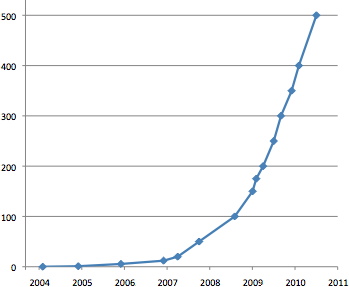
Fig1. Facebook Growth 2004–2010 – millions of users (data from Facebook, 2011).
[zoom image]
| 1999 | – | first implementation – stand-alone Java app with bespoke server later first web version using applet |
| 2000 | – | dot.com crash but seed funding for vfridge.com |
| 2002 | – | vfridge mothballed |
| 2010 | – | ‘facsimile’ version reproduced in PHP! |
Fig 2. Timeline of vfridge.
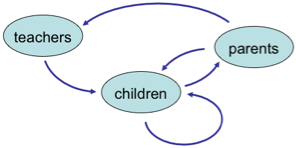
Fig. 3: Market ecology – tracing the
network of influences between
different stakeholders
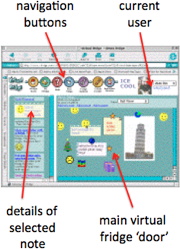
Figure 4: vfridge screenshot
[zoom image]
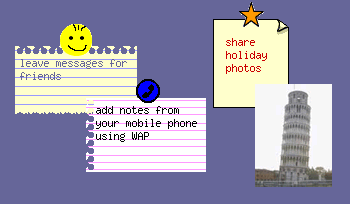
Fig. 5: Close up of notes on a fridge
[zoom image]
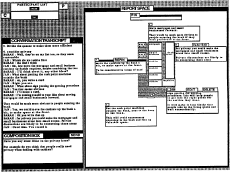
Fig. 6: Conferencer
[zoom image]
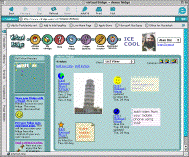
Fig. 7: 'List View' – multi-column layout
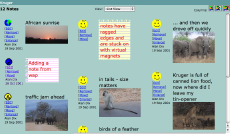
Fig. 8: List view close-up (three columns)
[zoom image]
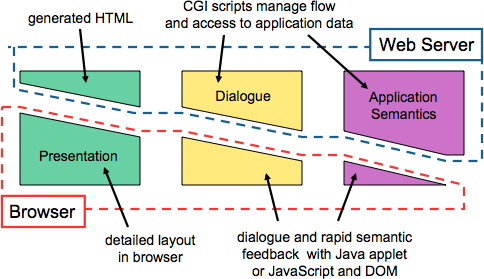
Fig. 9: Seeheim for Web Applications
(from Dix, 2011)
[zoom image]